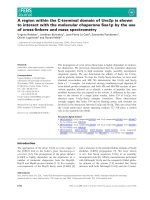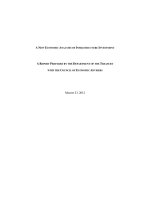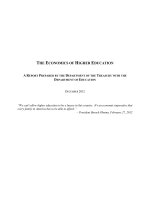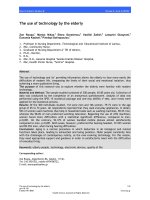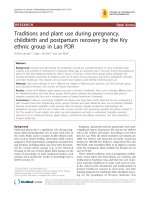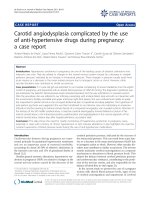CONCRETE PIPE USE MANUAL PREPARED BY THE ILLINOIS CONCRETE PIPE ASSOCIATION
Bạn đang xem bản rút gọn của tài liệu. Xem và tải ngay bản đầy đủ của tài liệu tại đây (6.09 MB, 39 trang )
CONCRETE PIPE
USE MANUAL
Prepared By
The Illinois Concrete Pipe Association
Table of Contents PAGE
SUBJECT 1
I. Introduction 2
II. Storm Sewers & Culverts 2
Introduction 3
Specifications 3
Circular Pipe (ASTM C14, C76, C655) 3
Arch Pipe (ASTM C506)
Elliptical Pipe (ASTM C507) 5
Precast Concrete Box Sections (ASTM C1577) 6
Burial Tables
Round RCP for Storm Sewers and Culverts 7
Elliptical RCP for Storm Sewers and Culverts 7
10
III. Sanitary Sewers 10
Introduction 11
Recommended Standard Specification
Plant Testing - Leakage Allowance 12
Field Testing - Leakage Allowed 12
Protective Lining Products 12
12
IV. Joints 12
Introduction 13
Mortar Joints
Rubber Gasket Joints (ASTM C443, C1628) 14
O-Ring Joints (ASTM C361) 15
External Bands (ASTM C877)
Butyl or Bitumen Rope (ASTM C990) 16
17
V. Manholes/Catch Basins and Inlets 18
Manhole Specifications (ASTM C478, C923) 19
Catch Basins and Inlets 20
21
VI. Flared End Sections/Fittings 22
Flared End Sections - Round, Elliptical, Arch, Box
Fittings - Bends
Fittings - Tees
Fittings - Manhole Tees
Fittings - Wyes
Fittings - Transitions
Fittings - Bulkheads
Table of Contents (Continued) PAGE
SUBJECT 23
23
VII. Testing
Plant Testing 23
3-Edge Bearing Test (ASTM C497)
Hydrostatic Test (ASTM C497) 23
Field Testing
Infiltration and Exfiltration Tests (ASTM C969) 24
Joint Acceptance Testing of Installed Precast Concrete Pipe 25
Sewer Lines (ASTM C1103) 25
25
VIII. Special Considerations 26
Hydraulic Coefficients 27
Industrial Wastes
Hydrogen Sulfide 29
Load Carrying Capacity 30
Significance of Cracking 30
Jacking 30
30
IX. Design Aids
ACPA Design Data Sheets 31
Design and Construction Manuals 31
Concrete Pipe Information 32
Computer Software 32
Informational Videos
33
X. List of Standards 34
ASTM Standards 35
AASHTO Standards 36
Standard Specifications for Water & Sewer Main Construction in Illinois
IDOT Standard Specifications for Road and Bridge Construction
XI. Dimensions & Weights
Reinforced Circular Concrete Pipe (English Units)
Reinforced Circular Concrete Pipe-Large Sizes (English Units)
Reinforced Concrete Elliptical Pipe (English Units)
Reinforced Concrete Box Sections (English Units)
CONCRETE PIPE USE MANUAL INTRODUCTION
I. INTRODUCTION
Concrete pipe has been used successfully for sewers and culverts in Illinois for over a century. By its very
nature, concrete pipe is an ideal drainage product that has the inherent advantage of hydraulic efficiency,
structural versatility, local availability, proven durability, construction adaptability, and economic superiority.
National specifications have been issued by the American Society for Testing and Materials, American
Association of State Highway and Transportation Officials, American Society of Civil Engineers and the Federal
Government for the purpose of ensuring uniform high quality products meeting specific physical requirements.
Concrete pipe is the modern manufactured conduit material with the longest history of excellent service and
widest acceptance. New processes, concrete mixes, designs, and unique features are constantly being introduced
to make it an even better engineered product for the future.
The purpose of this Manual is to provide information on concrete products available, specification designations,
and proper application in the sewer and culvert field. Although liability cannot be assumed, the technical data
presented here are considered reliable.
1
CONCRETE PIPE USE MANUAL STORM SEWERS & CULVERTS
II. STORM SEWERS & CULVERTS
INTRODUCTION
Storm sewers carry rainwater, surface water, ground water, cooling water, or other similar flows to a point of
safe discharge. They help protect much of the land we use for agriculture, industry, transportation, residences,
and recreation.
Concrete pipe, with its impressive record of strength and durability, is the most economical and reliable choice
of materials available today. Storm sewers require that pipe meet the strength requirements of any depth of fill
and live load, are hydraulically efficient, are non-combustible, and provide resistance to abrasion.
Culverts provide for the free passage of surface drainage water under a highway, railroad, canal, or other
embankment. Proper culvert design prevents the hazards and concurrent expenses of washouts, erosion,
flooding, and inundation of adjacent land.
Concrete pipe has been used for culverts in Illinois since the 1800s and much of it is still serving reliably.
Culverts must be strong to meet the embankment and traffic loads, durable, resistant to abrasion and combustion,
and available in a variety of shapes.
APPLICABLE SPECIFICATIONS AND RECOMMENDED USE
CIRCULAR PIPE
ASTM C14 Concrete Sewer, Storm Drain, and Culvert Pipe (Non-Reinforced)
C14 pipe is currently not in general use in Illinois. If desired, it may be used for sizes 12 in. through 36
in. diameter with the provision that C76 pipe of comparable strength also be specified. Joints provided
for most storm sewer construction employ cement mortar or mastic compound. For installations with
internal or external head condition, joints may be provided meeting the requirements of ASTM C443
utilizing a rubber gasket.
ASTM C76 Reinforced Concrete Culvert, Storm Drain, and Sewer Pipe
C76 pipe is used for sizes 12 in. through 144 in. diameter and is available with bell and spigot or tongue
and groove ends utilizing cement mortar or mastic compound joints. These joints are adequate for most
culvert and drainage installations. For the special condition of internal or external heads, joints may be
provided meeting the requirements of ASTM C443 or ASTM C361 utilizing a rubber gasket. ASTM
C76 pipe is the most commonly used storm sewer pipe because of its excellent hydraulic capacity,
resistance to abrasion and combustion, capabilities in meeting any variety of load conditions, and
availability with a number of related appurtenances.
2
CONCRETE PIPE USE MANUAL STORM SEWERS & CULVERTS
ASTM C655 Reinforced Concrete D-Load Culvert, Storm Drain, and Sewer Pipe
C655 pipe is used for sizes 12 in. through 144 in. diameter designed for a specific D-load strength.
Joints provided for most culvert and drainage employ cement mortar or mastic compound. The
properties of the pipe are similar to ASTM C76 pipe except that the pipe may be designed for a specific
D-load strength and the design accepted on the basis of a statistical analysis of test specimens.
SPECIAL SHAPE PIPE AND PRECAST CONCRETE BOXES
ASTM C506 Reinforced Concrete Arch Culvert, Storm Drain, and Sewer Pipe
C506 arch pipe is used for sizes 18 in. through 132 in. equivalent circular sizes and is available with
tongue and groove cement mortar or mastic compound joint. This arch-shaped pipe is used for minimum
cover situations or other conditions where vertical clearance problems are encountered. It offers the
hydraulic advantage of greater capacity for the same depth flow than most other structures or equivalent
waterway area. Loads under similar cover conditions are similar to that of circular pipe with the same
span. If arch pipe is not available in a certain area, elliptical pipe may be substituted as an equivalent.
ASTM C507 Reinforced Concrete Elliptical Culvert, Storm Drain, and Sewer Pipe
C507 horizontal elliptical pipe is used for sizes 18 in. through 144 in. equivalent circular sizes with
tongue and groove cement mortar or mastic compound joint. The horizontal elliptical pipe is installed
with the major axis horizontal and is used for minimum cover situations or other conditions where
vertical clearance problems are encountered. It offers the hydraulic advantage of greater capacity for the
same depth of flow than most other structures of equivalent waterway area. Loads under similar cover
conditions are similar to that of circular pipe with the same span.
C507 vertical elliptical pipe is used for sizes 36 in. through 144 in. equivalent circular sizes with tongue
and groove cement mortar or mastic compound joint. The vertical elliptical pipe is installed with the
major axis vertical and is used where minimum horizontal clearances are encountered or where unusual
strength characteristics are desired. Hydraulically, it provides higher flushing velocities under minimum
flow conditions and carries equal flow at a greater depth than equivalent horizontal elliptical, arch, or
circular pipe. Loads under similar cover conditions are similar to that of circular pipe with the same
span. Special installation techniques are required for vertical elliptical pipe.
ASTM C1577 Precast Reinforced Concrete Box Sections for Culverts, Storm Drains, and Sewers
C1577 box sections are used in sizes of span and rise from 3 ft. by 2 ft. to 12 ft. by 12 ft. Although not
specifically called out by ASTM C1577, 2 ft. by 2 ft. box sections are also locally available. The tables
provide design requirements for boxes installed under earth, dead and HL-93 live load conditions, for
design earth cover of 0 to 35 feet. Joints provided utilize tongue and groove type ends with cement
mortar or mastic compound joints. Box sections are used where special hydraulic requirements and
minimum cover are encountered. They offer the advantage of precast products over cast-in-place
construction through low installation costs and minimum inconvenience of weather and traffic delay.
3
CONCRETE PIPE USE MANUAL STORM SEWERS & CULVERTS
Box units may be used in parallel for multicell installations. Double-cell box sections are also available locally.
The following tables are provided from the Illinois Department of Transportation’s “Standard Specifications for
Road and Bridge Construction”, April 1, 2016 edition. Please note that all applicable IDOT provisions must be
adhered to when using these tables.
4
CIRCULAR RCP FOR STORM SEWERS & PIPE CULVERTS
STRENGTH CLASS REQUIRED FOR THE RESPECTIVE DIAMETERS OF CIRCULAR
PIPE AND FILL HEIGHTS OVER THE TOP OF THE PIPE FOR STORM SEWERS
& PIPE CULVERTS
Type 1 Type 2 Type 3 Type 4 Type 5 Type 6 Type 7
Nominal Fill Fill Height: Fill Height: Fill Height: Fill Height: Fill Height: Fill Height:
Diameter Height: Greater Greater Greater Greater Greater Greater
Inches 3’ and less than 3’ than 10’ than 15’ than 20’ than 25’ than 30’
with not not not not not not
1’ exceeding exceeding exceeding exceeding exceeding exceeding
minimum 10’ 15’ 20’ 25’ 30’ 35’
cover
10 NA NA NA NA NA NA NA
12 IV II III IV IV V V
15 IV II III IV IV V V
18 IV II III IV IV V V
21 III II III IV IV V V
24 III II III IV IV V V
27 III II III IV IV V V
30 IV II III IV IV V V
33 III II III IV IV V V
36 III II III IV IV V V
42 II II III IV IV V V
48 II II III IV IV V V
54 II II III IV IV V V
60 II II III IV IV V V
66 II II III IV IV V V
72 II II III IV V V V
78 II II III IV 2,020 2,370 2,730
84 II II III IV 2,020 2,380 2,740
90 II II III 1,680 2,030 2,390 2,750
96 II III III 1,690 2,040 2,400 2,750
102 II III III 1,700 2,050 2,410 2,760
108 II III 1,360 1,710 2,060 2,410 2,770
Notes: A number indicates the D-Load for the diameter and depth of fill and that a special design is
required.
Design assumptions: Water filled pipe, Type 2 bedding and Class C walls
5
ELLIPTICAL RCP FOR STORM SEWERS & PIPE CULVERTS
STRENGTH CLASS REQUIRED FOR ELLIPTICAL REINFORCED CONCRETE PIPE
OF THE RESPECTIVE EQUIVALENT ROUND SIZE OF PIPE AND FILL HEIGHTS
OVER THE TOP OF THE PIPE
Equivalent Reinforced Minimum Type 1 Type 2 Type 3
Round Concrete Fill Fill Height: Fill Height: Fill Height:
Size, Elliptical Pipe, Greater than
inches Height Not Greater
inches exceeding 3’ 3’ not than 10’ not
15 Span Rise 1’-0” exceeding exceeding
18 1’-0” HE-III
21 23 14 1’-0” HE-III 10’ 15’
24 1’-0” HE-III HE-III HE-IV
27 23 14 1’-0” HE-III HE-III HE-IV
30 1’-0” HE-III HE-III HE-IV
36 30 19 1’-0” HE-III HE-III HE-IV
42 1’-0” HE-II HE-III HE-IV
48 30 19 1’-0” HE-I HE-III HE-IV
54 1’-0” HE-I HE-III HE-IV
60 34 22 1’-0” HE-I HE-III HE-IV
66 1’-0” HE-I HE-III 1,460
72 38 24 1’-0” HE-I HE-III 1,460
HE-I HE-III 1,460
45 29 HE-III 1,470
HE-III 1,470
53 34
60 38
68 43
76 48
83 53
91 58
Notes: A number indicates the D-Load for the diameter and depth of fill and that a special design
is required.
Design assumptions: Water filled pipe, Type 2 bedding and Class C walls
6
CONCRETE PIPE USE MANUAL SANITARY SEWERS
III. SANITARY SEWERS
INTRODUCTION
Sanitary sewers are conduits that carry liquid and water-carried wastes from homes, commercial facilities,
industrial plants and institutions to a treatment plant for the express purpose of protecting our environment,
safeguarding health, and improving our comforts and quality of life.
Concrete pipe is the most widely used and accepted permanent product of all sanitary sewer materials. It makes
up the greater portion of the sanitary sewer system in most major cities in the United States. Sanitary sewers
require that pipe meet infiltration limits, meet the strength conditions of any depth of backfill and superimposed
load, and provide resistance to the effects of sewage.
RECOMMENDED STANDARD SPECIFICATION
1. SCOPE
1.1 - This specification covers reinforced concrete pipe intended to be used for the conveyance of waste
water.
2. REFERENCED DOCUMENTS
2.1 ASTM Standards:
C76 Reinforced Concrete Culvert, Storm Drain, and Sewer Pipe
C361 Reinforced Concrete Low-Head Pressure Pipe
C443 Joints for Circular Concrete Sewer and Culvert Pipe, Using Rubber Gaskets
C655 Reinforced Concrete D-Load Culvert, Storm Drain, and Sewer Pipe
C822 Definitions of Concrete Pipe and Related Products
C969 Infiltration and Exfiltration Acceptance Testing
C1103 Joint Acceptance Testing of Installed Pre-cast Concrete Pipe Sewer Lines
3. TERMINOLOGY
3.1 Definitions - For definitions of terms relating to concrete pipe, see Definitions C822.
4. MATERIALS
4.1 Reinforced Concrete Pipe – Reinforced concrete pipe shall be manufactured in accordance with
ASTM C76 or ASTM C655. The manufacturer of the reinforced concrete pipe shall be on the
Illinois Department of Transportation’s “List of Certified Plants.”
4.2 Pipe Class – The class of pipe shall be as shown on the plans.
7
CONCRETE PIPE USE MANUAL SANITARY SEWERS
4.3 Lift Holes – Lift holes shall not be permitted.
4.4 Joints – Joints shall conform to ASTM C443 or C361.
4.5 Gaskets – The gaskets shall be installed in accordance with the manufacturer’s
recommendations. Prior to commencing installation, the contractor shall submit to the engineer:
4.5.1 – Manufacturer’s literature on the type of gasket to be used.
4.5.2 – Manufacturer’s literature on the type of lubricant to be used.
4.5.3 – Manufacturer’s recommended installation procedures, including equalization
techniques.
4.6 Fittings – Fittings shall conform to the strength and water-tightness requirements placed upon
mainline pipe.
5. EXCAVATION
5.1 Trench Depth – The trench shall be excavated to a firm foundation at least 4 inches below the
bottom of the pipe so that the flow line of the finished sewer will be at the depth and grade specified
by the engineer.
5.2 Trench Width – For trench depths of less than 5 ft. and when sheeting or shoring is not required,
the trench shall be excavated 18 inches wider than the external diameter of the pipe. For trench
depths of 5 ft. or more and when sheeting or shoring is required, the trench width shall be 3 ft. wider
than the external diameter of the pipe.
6. BEDDING
6.1 – Bedding material (pea gravel, crushed stone or washed gravel with at least 95% passing the 1”
sieve) shall be placed at least 4” thick on the bottom of the trench. If any unyielding foundation is
encountered, the minimum thickness shall be increased to 8”.
7. INSTALLATION
7.1 Handling – The contractor shall handle the pipe with care and avoid chipping or cracking the
pipe.
7.2 Laying Pipe – The contractor shall keep the trench free from water during installation. The
laying of pipe shall proceed upgrade, with spigot or tongue ends pointing in the direction of flow.
The ends of the pipe shall be carefully cleaned before they are lowered into the trench. Each pipe
shall be carefully aligned horizontally and vertically with the previous pipe and the joint pulled
home. Care shall be taken to assure the gasket remains in its intended position.
8
CONCRETE PIPE USE MANUAL SANITARY SEWERS
8. BACKFILLING
8.1 Haunch – As soon as possible the entire width of the trench shall be backfilled with pea gravel,
crushed stone or washed gravel (with at least 95% passing the 1” sieve) to the pipe springline.
Special care shall be taken to completely fill the space under the pipe. A flowable backfill mixture,
described as controlled low strength material (CLSM), may be used.
8.2 Backfill – The remainder of the trench shall be backfilled to the natural grade or finished surface.
This material may consist of material excavated from the trench. Care shall be taken to avoid
disturbing the pipe.
8.3 Special Considerations – In areas where the trench will be under pavements, curbs, shoulders,
sidewalks or other structures, granular material will be used to fill the entire trench. The granular
material will be placed and compacted to the satisfaction of the engineer. A flowable CLSM may be
used when high relative densities are desired.
9. ACCEPTANCE TESTING
9.1 Types of Testing – Testing for acceptance of reinforced concrete pipe shall be conducted by one
of the following methods:
9.1.1 – Water exfiltration, ASTM C969
9.1.2 – Water infiltration, ASTM C969
9.1.3 – Joint testing, ASTM C1103
9.2 Test Sections – Unless otherwise specified or directed by the engineer, the first 1200 feet (or the
entire length if the project is less than 1200 feet) shall be tested before additional excavation is
permitted. If the initial section does not pass, it shall be repaired and retested until a satisfactory
result is obtained. Excavation shall not proceed beyond the first 1200-foot section until satisfactory
results are obtained.
In the event the first 1200-foot section did not pass the test on the first trial, the next section of
sanitary sewer approximately 1200 feet long shall also be tested, repaired if necessary, and restored
until a satisfactory result is obtained. Additional excavation shall not be started until this section has
passed.
When favorable test results are obtained on the first trial for a full 1200-foot section, the engineer
may designate additional sections for testing. The engineer reserves the right to select the location
and lengths of additional test sections. All testing will be performed within 30 days of backfilling.
9.3 Water Exfiltration – The test shall be conducted in accordance with ASTM C969.
9.4 Water Infiltration – The test shall be conducted in accordance with ASTM C969.
9.5 Joint Acceptance Testing – The test shall be conducted in accordance with ASTM C1103.
9
CONCRETE PIPE USE MANUAL SANITARY SEWERS
PLANT TESTING – LEAKAGE ALLOWANCE
Most manufacturers are willing to test sewer pipe in their yard prior to shipment to ensure that the barrels of
the pipe will not leak. Random vacuum testing of an assembly of two or more sections of pipe can also be
performed at the place of manufacture to assure the integrity of the pipe joints.
FIELD TESTING – LEAKAGE ALLOWED
Infiltration should be held to a minimum in sanitary sewers since it reduces the carrying capacity of the
sewer, keeps associated sewer system treatment costs at a minimum, and eliminates maintenance and
operating costs arising from soil fines entering the system under infiltration situations. Acceptable
infiltration limits have varied widely over the years but the trend in recent years has been to require sewers
to meet low infiltration limits. Low leakage requirements can be met with well-made concrete gravity
sewer pipe and rubber gasket joints. It should be recognized by the engineer, however, that field
performance represents the sum of the manufactured joint characteristics and the contractor’s installation
practices.
In making the joint on rubber gasket sewer pipe, the pipe being installed should be held by the lifting device
straight to line and grade with the pipe in the ground. The pipe must not be held at an angle when entry is
started to avoid the gasket being pinched between the shoulder of the spigot and bell at the bottom of the
pipe. With the spigot carefully aligned at the entrance to the bell and with the pipe to be installed held in
line with the previously laid pipe, the joint should be pulled home slowly.
To check on whether reasonable workmanship was realized during the construction phase, maximum limits
of allowable leakage in terms of water infiltration or exfiltration are usually included in project
specifications. They should be stated in terms of both maximum allowable rate per test section and
maximum allowable average rate for the total project. These project acceptance tests evaluate the quality of
the contractor’s work.
There are many opinions, but not much hard data, upon which to base infiltration requirements that are
generally cost-effective. There will always be at least a small increment of infiltration which is not cost-
effective to eliminate. The expense of the pipe and increases in construction and inspection costs fix the
lower limit for infiltration allowance.
Current information indicates that the 200 gallons/mile/inch-diameter/day can normally be achieved in
manhole to manhole tests with minimum to no effect on construction cost. A higher allowable leakage limit
should be used for an exfiltration test over that used for an infiltration test. This is because the exfiltration
test is performed with a definite internal pressure head, and the exfiltration of clear water out of the pipe is
less likely to be reduced than the infiltration of ground water mixed with soil fines into the pipe.
A ready reference for information on construction leakage allowances in sewers and methods of test is
provided in the EPA “Manual of Practice, Sewer System Evaluation, Rehabilitation and New Construction.”
10
CONCRETE PIPE USE MANUAL SANITARY SEWERS
PROTECTIVE LINING PRODUCTS
Present design methodology for sanitary sewers gives the designer the ability to predict the potential for
hydrogen sulfide production. Available references include EPA’s “Design Manual on Odor and Corrosion
Control in Sanitary Sewerage Systems and Treatment Plants” and ACPA’s “Design Manual, Sulfide and
Corrosion Prediction and Control.” If the potential for hydrogen sulfide production is determined to be
significant, linings or coatings may be used to protect the inner pipe surface from corrosion.
Available liners consist of a sheet of plasticized PVC with T-shaped keys running longitudinally along one
face. The keys are cast into the concrete pipe during manufacture. PVC liners have been used very
successfully for over 30 years.
Available coatings may consist of coal tar/epoxy, polyethylene or polyurethane. Coal tar/epoxy coatings are
applied by spraying either during or after manufacture of the concrete pipe in varying thicknesses. These
coatings have proven to be effective providing adequate surface preparation is performed, adequate
thickness is applied and adequate quality control procedures are followed.
11
CONCRETE PIPE USE MANUAL JOINTS
IV. JOINTS
INTRODUCTION
Joint configurations include bell and spigot, tongue and groove and modified tongue and groove. Joint
gaskets and sealants fall into the general categories of cement mortar or mastic sealants, rubber gaskets,
external sealing bands, steel end rings, and butyl or bitumen rope. Although the primary considerations in
joint quality are permissible infiltration and exfiltration rates, other important performance requirements
include: resistance to infiltration of backfill material, control of leakage due to internal or external pressure,
flexibility to accommodate lateral deflection of longitudinal movement, pipeline continuity and smooth flow
line, infiltration of groundwater for subsurface drainage, and ease of installation.
CEMENT MORTAR AND MASTIC COMPOUND
Circular pipe, special shapes and boxes are available with tongue and groove joints that may be packed with
cement mortar, filled with a preformed butyl or bitumen gasket sealing compound or a trowel applied mastic
compound. Such joints have a successful experience record and are generally used for storm sewer
construction. Properly applied mastic joint fillers provide flexibility and help to keep fines out of the pipe.
ASTM C443 Joints for Circular Concrete Sewer and Culvert Pipe, Using Rubber Gaskets
Joints recommended for circular sewers where infiltration or exfiltration is a factor in design are the
following flexible watertight joints using compression type rubber gaskets for sealing the joints.
C443 joints are intended for use with pipe manufactured to meet the requirements of ASTM C76 and
may be used with either bell and spigot or tongue and groove pipe. The joint is made up of concrete
surfaces, with a compression type rubber gasket. O-ring type joints will also meet the performance
requirements of C443.
ASTM C361 Reinforced Concrete Low-Head Pressure Pipe
Although ASTM C361 covers both low-head pressure pipe and the joint requirements for this type
of pipe, it is referenced here for special conditions of internal or external head. C361 joints can be
supplied for use with pipe manufactured to meet the requirements of ASTM C76. The joint is made
up of concrete surfaces with a groove on the spigot for an O-ring rubber gasket (also referred to as a
confined O-ring type joint). Provisions are made in Section 8 for an alternative joint as approved by
the owner. These joints are normally used in gravity sewers where exceptional tightness is required.
This type of joint meets all the joint requirements of ASTM C443. Steel end rings may also be used
for the special condition of pressure flow.
ASTM C877 External Sealing Bands for Non-Circular Concrete Sewer, Storm Drain and Culvert Pipe
For special conditions where an effective rubber seal is desired for jointing non-circular concrete
pipe (arch, elliptical and box shapes), an external sealing band is available meeting the requirements
of ASTM C877. These sealing bands are generally limited to non-circular pipe with tongue and
groove configurations. ASTM C877 describes specific types of external sealing bands. Other types
of sealing bands with adequate results may also be specified.
12
CONCRETE PIPE USE MANUAL JOINTS
ASTM C990 Joints for Concrete Pipe, Manholes and Precast Box Sections Using Preformed Flexible Joint
Sealants
C990 joints are intended for use with circular pipe, elliptical pipe or precast box sections and may be
used with either bell and spigot or tongue and groove pipe. The joint is made up of concrete
surfaces, with a preformed bitumen or butyl rubber sealant and is also referred to as bitumen or butyl
rubber rope.
13
CONCRETE PIPE USE MANUAL MANHOLES/CATCH BASINS/INLETS
V. MANHOLES/CATCH BASINS/INLETS
INTRODUCTION
Manholes and certain appurtenances are necessary for the proper functioning of a complete sewer and
culvert system. They may include manholes, inverted syphons, catch basins and inlets, flared end sections,
and fittings such as bends, tees, and wyes. The concrete pipe industry has developed most of the common
appurtenances and specials necessary for efficient and economical performance of the complete system.
MANHOLES
ASTM C478 Precast Reinforced Concrete Manhole Sections
C478 manhole sections including risers, base sections, and appurtenances, such as grade rings and
flat slab tops, are used in sizes 36 in. and larger diameters. Also available for large sewers over 3 or
4 ft. in diameter are precast base tees. The riser sections are of circular cross section and may
employ an eccentric, concentric cone section or a flat slab top. Cone sections affect the transition
from the inside diameter of the riser sections to the top opening. Flat slab tops are normally used for
very shallow manholes.
Precast barrel sections (riser sections) are available locally in the following sizes:
I.D./O.D.: 36”/44”, 48”/58”, 60”/72”,72”/86”, 84”/100”, 96”/114”
Lengths: 12”, 16”, 24”, 32”, 36”, 42”, 48”, 60”, 72”, 84”, 96” (depending on diameter)
Bottoms are available cast in or loose.
Precast cone sections, eccentric or concentric, are available locally in the following sizes:
36” I.D./18” long
48” I.D./24”, 30”, 36”, 38”, 48”, 52”, 54” long
60” I.D./42”, 48” long
Flattops are available locally in the following sizes:
36” I.D./6” thick
48” I.D./6”, 8” thick
60” I.D./8” thick
72” I.D./8” thick
84” I.D./8” thick
96” I.D./8”, 10”, 12” thick
The manhole assembly may be furnished with or without steps inserted into the walls of the sections. Steps
are cast, mortared or attached by mechanical means into the wall of the section and may be made of plastic
encapsulated steel, aluminum, or cast iron. Inverts are available for 36”, 48”, 60” and 72” precast barrels. A
number of joints are used for manhole risers and cones including cement mortar, mastic compound, and
rubber gaskets for sealing purposes. Asphalt or coal tar epoxy coatings can also be furnished. Manhole
adjusting rings (spacers) are available in thicknesses of 2”, 4” and 6”. Precast concrete headwalls (IDOT
Standard #1976) are available for 8”, 10”, 12”, 15”, 18”, 21”, 24”, 27”, 30”, 36”, 42” and 48” diameter pipe.
14
CONCRETE PIPE USE MANUAL MANHOLES/CATCH BASINS/INLETS
ASTM C923 Resilient Connectors between Reinforced Concrete Manhole Structures and Pipes
C923 Resilient Connectors are available for special conditions of internal or external head, providing
a water resistant connection between the manhole and pipe. These connections are generally used
only for sanitary sewer applications. They are locally available for 3”, 4”, 6”, 8”, 10”, 12”, 14”, 15”,
16”, 18”, 20”, 21”, 24”, 27”, 30”, and 36” diameter pipes.
CATCH BASINS AND INLETS
Catch basins are available in 2 ft. through 5 ft. diameters in variable lengths. Inlets are available in 2 ft.
diameters in various lengths. Catch basins and inlets may be manufactured with precast bottom sections.
Special precast inlet boxes are also manufactured for use in highway median sloped ditch checks.
Some typical manhole
assemblies are pictures
below:
15
CONCRETE PIPE USE MANUAL FLARED END SECTIONS/FITTINGS
VI. FLARED END SECTIONS/FITTINGS
FLARED END SECTIONS
Precast flared end sections for circular concrete pipe are manufactured in diameters of 12 in. through 84 in. and
in sizes of 14” x 23” to 48” x 76” and 58” x 91” for elliptical pipe with the groove end on the outlet and tongue
end on the inlet section. Precast flared end sections are also available for many sizes of elliptical pipe and
precast box sections. Steel grates are available for all types of flared end sections. Toe blocks may be employed
to support the outlet of flared end sections. Various examples of flared end sections are pictured below.
FLARED END SECTIONS FLARED END SECTION W/ GRATE
STEEL GRATES
16
CONCRETE PIPE USE MANUAL FLARED END SECTIONS/FITTINGS
FITTINGS – BENDS
Bends are furnished in standard ranges of 15 degree angular deflections although specials can be manufactured
to meet any required deflection. The bend is formed by cutting the pipe barrel to the desired bevel, spot welding,
or tying together the exposed reinforcing, and packing the seams with cement mortar. Pipe bends should be
equal in design strength to the abutting pipe. Bends are locally available for circular and elliptical pipe in the
following sizes and angles:
Circular Pipe Elliptical Pipe
Pipe Diameter (in.) Bend Angle (o) Mainline Pipe Size (in.) Equivalent Round Size (in.) Bend Angle (o)
96 5 to 45 63 x 98 78 5 to 45
84 5 to 45 58 x 91 72 5 to 45
72 5 to 45 53 x 83 66 5 to 45
66 5 to 45 48 x 76 60 5 to 60
60 5 to 90 43 x 68 54 5 to 90
54 5 to 90 38 x 60 48 5 to 90
48 5 to 90 34 x 53 42 5 to 90
42 5 to 90 29 x 45 36 5 to 90
36 5 to 90 24 x 38 30 5 to 90
30 5 to 90 19 x 30 24 5 to 90
27 5 to 90 14 x 23 18 5 to 90
24 5 to 90
21 5 to 90
18 5 to 90
15 5 to 90
12 5 to 90
10 5 to 90
8 5 to 90
Note: Generally, a manhole riser may be added to a bend, providing
the riser is smaller in diameter than the mainline pipe.
17
